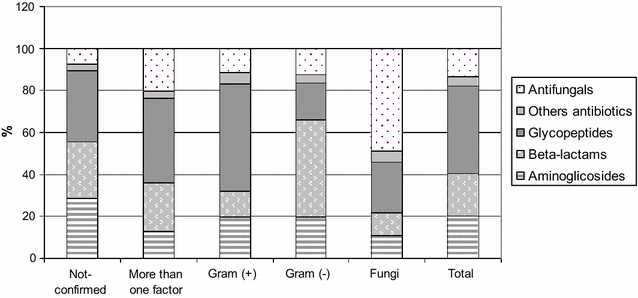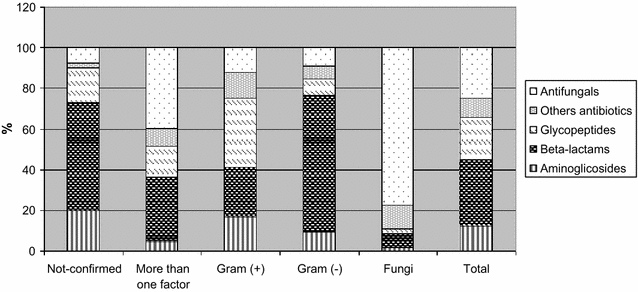Antibiotic consumption in laboratory confirmed vs. non-confirmed bloodstream infections among very low birth weight neonates in Poland
- PMID: 28359268
- PMCID: PMC5374675
- DOI: 10.1186/s12941-017-0196-y
Antibiotic consumption in laboratory confirmed vs. non-confirmed bloodstream infections among very low birth weight neonates in Poland
Abstract
Background: Newborns are a population in which antibiotic consumption is extremely high. Targeted antibiotic therapy should help to reduce antibiotics consumption. The aim of this study was an assessment of antibiotic usage in bloodstream infections treatment in the Polish Neonatology Surveillance Network (PNSN) and determining the possibility of applying this kind of data in infection control, especially for the evaluation of standard methods of microbiological diagnostics.
Methods: Data were collected between 01.01.2009 and 31.12.2013 in five teaching NICUs from the PNSN. The duration of treatment in days (DOT) and the defined daily doses (DDD) were used for the assessment of antibiotics consumption.
Results: The median DOT for a single case of BSI amounted to 8.0 days; whereas the median consumption expressed in DDD was 0.130. In the case of laboratory confirmed BSI, median DOT was 8 days, and consumption-0.120 DDD. Median length of therapy was shorter for unconfirmed cases: 7 days, while the consumption of antibiotics was higher-0.140 DDD (p < 0.0001). High consumption of glycopeptides expressed in DOTs was observed in studied population, taking into account etiology of infection.
Conclusions: Even application of classical methods of microbiological diagnostics significantly reduces the consumption of antibiotics expressed by DDD. However, the high consumption of glycopeptides indicates the necessity of applying rapid diagnostic assays. Nevertheless, the assessment of antibiotic consumption in neonatal units represents a methodological challenge and requires the use of different measurement tools.
Keywords: Antimicrobial consumption; Bloodstream infections; Infection surveillance; Neonatal infections.
Figures
Similar articles
-
[Antibiotic consumption and its costs of purchase in Polish neonatology networks units].Przegl Epidemiol. 2012;66(3):513-9. Przegl Epidemiol. 2012. PMID: 23230725 Polish.
-
Late-onset bloodstream infections of Very-Low-Birth-Weight infants: data from the Polish Neonatology Surveillance Network in 2009-2011.BMC Infect Dis. 2014 Jun 18;14:339. doi: 10.1186/1471-2334-14-339. BMC Infect Dis. 2014. PMID: 24939563 Free PMC article.
-
Newborn Antibiotic Exposures and Association With Proven Bloodstream Infection.Pediatrics. 2019 Nov;144(5):e20191105. doi: 10.1542/peds.2019-1105. Epub 2019 Oct 22. Pediatrics. 2019. PMID: 31641017
-
Literature review on the distribution characteristics and antimicrobial resistance of bacterial pathogens in neonatal sepsis.J Matern Fetal Neonatal Med. 2022 Mar;35(5):861-870. doi: 10.1080/14767058.2020.1732342. Epub 2020 Feb 26. J Matern Fetal Neonatal Med. 2022. PMID: 32102584 Review.
-
Antibiotic regimens for late-onset neonatal sepsis.Cochrane Database Syst Rev. 2021 May 8;5(5):CD013836. doi: 10.1002/14651858.CD013836.pub2. Cochrane Database Syst Rev. 2021. PMID: 33998665 Free PMC article.
Cited by
-
Antibiotic consumption and antimicrobial resistance in Poland; findings and implications.Antimicrob Resist Infect Control. 2018 Nov 15;7:136. doi: 10.1186/s13756-018-0428-8. eCollection 2018. Antimicrob Resist Infect Control. 2018. PMID: 30473786 Free PMC article.
-
A longitudinal analysis of nosocomial bloodstream infections among preterm neonates.Eur J Clin Microbiol Infect Dis. 2022 Nov;41(11):1327-1336. doi: 10.1007/s10096-022-04502-8. Epub 2022 Sep 30. Eur J Clin Microbiol Infect Dis. 2022. PMID: 36178568 Free PMC article.
-
Can surgical site infections be controlled through microbiological surveillance? A three-year laboratory-based surveillance at an orthopaedic unit, retrospective observatory study.Int Orthop. 2019 Sep;43(9):2009-2016. doi: 10.1007/s00264-019-04298-x. Epub 2019 Jan 24. Int Orthop. 2019. PMID: 30680519 Free PMC article.
-
Effect of Weekly Antibiotic Round on Antibiotic Use in the Neonatal Intensive Care Unit as Antibiotic Stewardship Strategy.Front Pediatr. 2020 Dec 15;8:604244. doi: 10.3389/fped.2020.604244. eCollection 2020. Front Pediatr. 2020. PMID: 33384975 Free PMC article.
References
-
- Stoll BJ, Hansen NI, Bell EF, Shankaran S, Laptook AR, Walsh MC, et al. The Eunice Kennedy Shriver National Institute of Child Health and Human Development Neonatal Research Network: neonatal outcomes of extremely preterm infants from the NICHD Neonatal Research Network. Pediatrics. 2010;123(3):443–456. doi: 10.1542/peds.2009-2959. - DOI - PMC - PubMed
-
- Versporten A, Sharland M, Bielicki J, Drapier N, Vankerckoven V, Goossens H. The antibiotic resistance and prescribing in European children project. A neonatal and pediatric antimicrobial web-based point prevalence survey in 73 hospitals worldwide. Pediatr Infect Dis J. 2013;32(6):242–253. doi: 10.1097/INF.0b013e318286c612. - DOI - PubMed
MeSH terms
Substances
LinkOut - more resources
Full Text Sources
Other Literature Sources
Medical
Research Materials



